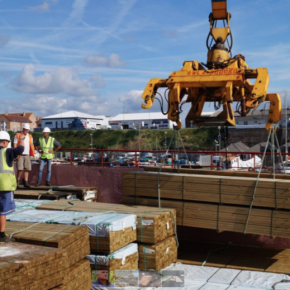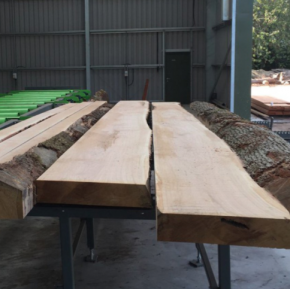
Carbon abatement potential in UK construction; it starts with trees
In February 2019, the Committee for Climate Change commissioned a research project into the possible reduction of greenhouse gases, by increasing the use of timber in UK construction. The findings have been released in a report entitled ‘Wood in Construction in the UK: An Analysis of Carbon Abatement Potential’.
 Independent not-for-profit organisation, Grown in Britain (GiB), is a team of industry leaders, working to improve the UK’s approach to home-grown timber. Here, Grown in Britain‘s CEO Dougal Driver, looks at how the potential abatement of carbon could be turned into reality, by encouraging and implementing a new ethos around the management and use of UK woodlands.
Independent not-for-profit organisation, Grown in Britain (GiB), is a team of industry leaders, working to improve the UK’s approach to home-grown timber. Here, Grown in Britain‘s CEO Dougal Driver, looks at how the potential abatement of carbon could be turned into reality, by encouraging and implementing a new ethos around the management and use of UK woodlands.
In the last 30 years, great technological strides have been made in some particularly impressive areas; the internet, DNA testing, sustainable energy, etc. And as we approach the next 30 years, we can look forward to a whole new set of advances, which will of course bring their own new challenges.
So with all the progress we are making across other sectors, it remains disappointing that we are yet to implement particular changes in our use of UK timber, which could make massive contributions to the possibilities outlined in the new report.
It’s a little known fact, and one that Grown in Britain is working hard to highlight, that the UK imports more than £7.8 billion worth of timber from elsewhere around the globe, every year.
In our consumption of foreign timber, we are second only to China. 43% of our own woodlands are under managed, and shockingly, much of the UK’s hardwood is needlessly imported from France and Germany, with only 7% of UK consumption being of home-grown origin.
 This is highly relevant to a particular finding of the report which states that currently, over 50% of a building’s carbon footprint is embodied, i.e., comes as a result of the extraction, manufacture, transportation, demolition and disposal of its core materials. Concrete and brick, are widely acknowledged as being intensive in their embodied carbon rates, whilst the levels of sequestered (stored) carbon they offer are very low.
This is highly relevant to a particular finding of the report which states that currently, over 50% of a building’s carbon footprint is embodied, i.e., comes as a result of the extraction, manufacture, transportation, demolition and disposal of its core materials. Concrete and brick, are widely acknowledged as being intensive in their embodied carbon rates, whilst the levels of sequestered (stored) carbon they offer are very low.
So with that in mind, what difference would a high growth in timber use, across the UK construction sector, actually make?
Well, according to the findings, the figures are substantial. In the UK residential building sector alone, an increase in timber use has the potential for an 18-19% reduction in embodied carbon, and most importantly, a huge 59-64% increase in sequestered carbon.
This is further supported in the report’s conclusion, that “while reduction of embodied carbon within buildings can be achieved through various measures, an increase in stored sequestered carbon can only be achieved by increased use of biomass-based materials such as timber.”
From the way we manage our woodlands, right through the various stages of the supply chain, this area of the UK construction industry, presents numerous possibilities for change; change which not only promises significant benefits to the global climate, but which would also result in positive knock-on effects for local economies, immediate surroundings and nationwide flora and fauna.
An increase in managed UK woodlands would not only mean less imports, it would also provide cleaner air, reduce flooding and enhance our wildlife habitats. This is all in addition to the long-term financial stability it would bring to UK industry, both in terms of local jobs and the wider economy.
In another recent report commissioned by the CCC, this time looking at the UK’s target for net-zero greenhouse gases by 2050, specific reference was made to timber handling. It recommended afforestation of around 30,000 hectares per year was needed in the UK; this would mean increasing woodland cover from the current 13% of UK land area, to a preferable 17%. Combining this with an increase in active woodland management, would have a massive impact on the forest carbon sink, i.e., the natural reservoir of stored carbon that accumulates in our managed woodlands.
The points made so far, already make a strong case for the use of home-grown timber – but there’s more. We have yet to touch on the subject of transport. The logistics, financial costs and resulting carbon emmissions, generated by moving huge amounts of timber all around the planet, are significant.
One of the most immediate ways we can start embracing the potential of our own woodlands, is to look for the Grown in Britain logo on our forest products. Any timber or timber product displaying the logo, brings the assurance that relevant checks have been made into its origins, and the processes used in its production.
From governing bodies, parliamentary committees and organisations such Grown in Britain; through to buyers, suppliers and the public – we are all responsible for the safeguarding of our planet and its resources. Whilst some hugely intricate changes may be required in certain areas of climate control, this certification scheme is already available and straight-forward to implement – we just need to re-think our existing attitudes towards the use of forest timber as a construction material.
The UK’s woods and forests are amazing – and their future is in our hands. We need to work together in realising their carbon abatement potential – and we can start by making sure our timber is certified as Grown in Britain
Latest news

19th April 2024
ASSA ABLOY: Access solutions can impact sustainability performance across the full life-cycle of a building
Embedding sustainability within any organisation requires a broad, strategic perspective. Scrutiny should include the physical infrastructure itself: According to the IEA, buildings consume around 30% of global energy*. ASSA ABLOY has more…
Posted in Access Control & Door Entry Systems, Architectural Ironmongery, Articles, Building Industry News, Building Products & Structures, Building Regulations & Accreditations, Building Services, Case Studies, Doors, Facility Management & Building Services, Information Technology, Research & Materials Testing, Retrofit & Renovation, Security and Fire Protection, Sustainability & Energy Efficiency, Video of the Week
19th April 2024
British weather doesn't dampen spirit for new HMG Garden Paint
Despite one of the wettest starts to the year on record, customers are starting to plan for brighter days with HydroPro Garden Paint from HMG Paints.
Posted in Articles, Building Industry News, Building Products & Structures, Garden, Innovations & New Products, Paints, Paints, Coatings & Finishes, Restoration & Refurbishment, Retrofit & Renovation, Site Preparation, Sustainability & Energy Efficiency, Waste Management & Recycling
18th April 2024
Abloy UK showcases new digital portfolio at The Security Event 2024
Abloy UK is set to unveil its latest line-up of access control systems at The Security Event 2024, welcoming guests to explore its cutting-edge electromechanical and digital solutions on stand 5/F50.
Posted in Access Control & Door Entry Systems, Architectural Ironmongery, Articles, Building Industry Events, Building Industry News, Building Products & Structures, Building Services, Doors, Exhibitions and Conferences, Facility Management & Building Services, Health & Safety, Information Technology, Retrofit & Renovation, Security and Fire Protection
18th April 2024
Strand is a Failsafe Choice for Emergency Exit and Panic Hardware
In times of emergency, you’re in safe hands with Strand Hardware. Although there are many considerations for building specification, few decisions can be as critical as selecting the right emergency exit/panic hardware.
Posted in Access Control & Door Entry Systems, Architectural Ironmongery, Articles, Building Industry News, Building Products & Structures, Building Services, Doors, Facility Management & Building Services, Health & Safety, Restoration & Refurbishment, Retrofit & Renovation, Security and Fire Protection
 Sign up:
Sign up: